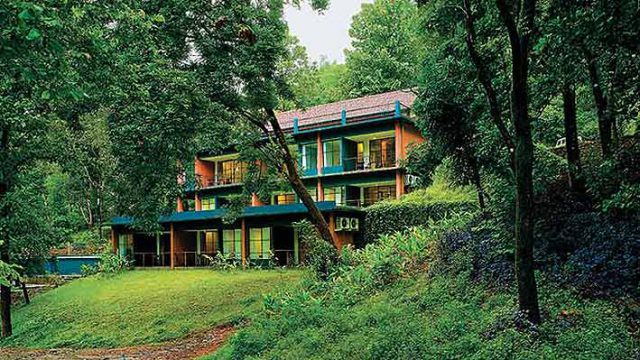I was distracted briefly from the fabulous view of a waterfall from my room by a note that advised me not to get too worked up about lizards and spiders, and to definitely avoid killing them. Rainforest is a luxury resort, though, with rooms that can seal fairly hermetically, so I didn’t need to punctuate my stay there with shooing away intrepid arachnids.

In any case I didn’t need to spend very much time in the room. Like most places that need to warn guests about bugs, Rainforest is situated in a biodiversity hotspot, one that is particularly beautiful. It directly faces the Athirapally Falls (all its nine rooms have a great view); at about 30m, the steepest drop along the 145km path that the Chalakudy River carves through Kerala as it descends from its source in Anamalai Hills, Tamil Nadu.
The Chalakudy is home to around 100 species of fish, a staggering statistic for such a short river in a densely populated state. In its upper course, it flings itself through the rocky reaches where the Western Ghats descend to Kerala’s narrow coastal strip. There’s a whitewater boom that will bring a smile to anyone who has shot a rapid, and it’s all in the middle of forests that are home to elephants, sambhar, wild boar, giant squirrel, leopard, a few tigers and more birds, butterflies, other insects and spiders, turtles and amphibians than you can count — literally, since several of the species found here are found nowhere else on earth, with new ones still being discovered.

It’s a world far removed from city life, and one that Rainforest is nicely positioned to show you — all good resorts can do the luxury, the creature comforts, the good food that you would expect, and so does this one. But it’s something else that makes a stay memorable. Rainforest is the only local option for luxury, but it also does two things rather well, one of which is the view of the falls. The other is the services of a remarkable man called Baiju. His is a classic poacher-turned-gamekeeper story. He grew up in a nearby hamlet, hunting down forest creatures for sport and fun. Today he is a literate and articulate spokesperson for the local ecology, which he loves passionately, and is happy to show you the jungle in a way that few others can.
That’s why I eschew the comforts of my room and take off into the jungle with Baiju one afternoon. We set up overnight camp near a Kadar (one of four endemic tribes) village, just by the shore of a reservoir. There’s a spectacular show of bird life. Elegant river terns peel off into dives when they see a fish, herons stalk the shores with grim intent, handsome black woodpeckers pound at tree trunks and, every once in a while, there’s a sound that writers of horror and fantasy often invoke, but few get to hear — the beating of great wings. It’s a Great Indian Hornbill, the largest and most spectacular of all hornbills. The noise it makes is likened by locals to the sound that moves mountains.
Baiju puts together a meal that has probably changed little in centuries, fish and tapioca cooked in bamboo, which is turned gently over a log fire. The delicious meal is just an aperitif for more of the jungle, because as we take a drive that evening along the nearby road that goes from Chalakudy to Pollachi in Tamil Nadu, we see elephant, sambhar, night jars, owls and finally something that looks like a squirrel apparently wearing an oversized fur coat. It’s a flying squirrel, and that floppy coat comes into its own when the animal stretches its limbs, turns it into a wing-like structure and glides 70m from tree to tree.
Back at Rainforest the next day I’m digging into a truly outstanding beef coconut fry (this is a classic of Kerala Christian cuisine, and is often done well, but it is uncommon to come across a masterpiece, like this one), when I’m reminded that there are even less likely aviators than the squirrel lurking about. A brown lump on a tree trunk, one that’s nearly indistinguishable from the bark, suddenly goes all high-visibility orange as it extends its rib cage into a flat plane. It’s a flying lizard taking the quick way to a nearby tree.
I see several more on the path down from the resort to the base of the waterfall. Legend likens the shape of the waterfall to the flow out of the fist of Ayyappa, and from this angle, it’s possible to see why. The area also resonates with me in a way that’s puzzlingly familiar, and I’m wondering why until Baiju puts me out of my misery: many key scenes of the Tamil classic Punnagai Mannan, a film I’ve seen several times, were shot here.
For others, the local resonance of the spot is more visceral. The state wants to put an additional dam up-river from the falls. The authorities argue that electricity is desperately required, which is of course true. Meanwhile activists (they tend to be vocal, well-researched and fairly formidable in these parts) counter that the economics of the project benefit very few and will impose colossal environmental and social costs with the impact on the river’s flow and on the forests and fauna in the region. So far the dam hasn’t come up, though survey work for the project continues.
As far as I’m concerned the threat of change is merely an impetus to keep returning before it changes any more from its current state of quite captivating beauty.
The information
Where: 55km from Kochi airport/85km from Kochi. Travel north along NH 47 to Chalakudy, and turn right for Pollachi. The resort is 30km along this road.
Accommodation: 9 rooms: 6 Luxury, 2 Premium, 1 Celestial Grade
Tariff: Rs. 9,000 (Luxury), Rs. 11,250 (Premium), Rs. 13,500 (Celestial). Credit cards not accepted.
Contact: 0484-2315301, www.avenuehotels.in




